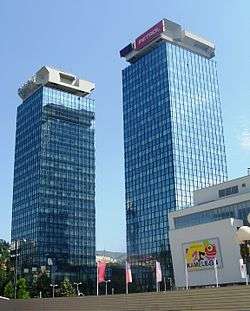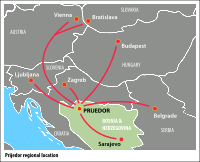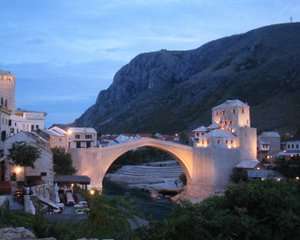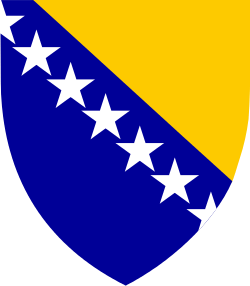Economy of Bosnia and Herzegovina
 | |
| Currency | Bosnia and Herzegovina convertible mark |
|---|---|
| Calendar year | |
Trade organisations | CEFTA |
| Statistics | |
| GDP |
|
| GDP rank |
112th (nominal, 2015) / 113th (PPP, 2015) |
GDP growth |
|
GDP per capita |
|
GDP by sector |
agriculture: 8.1% industry: 26.4% services: 65.3% (2013 est.) |
|
| |
Population below poverty line | 42,1% (2011) |
Labour force |
|
| Unemployment | 44,6% CIA World fact book (2015 est.) |
Average gross salary |
82http://www.bhas.ba/?lang=en8 BAM / |
|
| |
Main industries | steel, coal, iron ore, lead, zinc, manganese, bauxite, vehicles, textiles, tobacco products, furniture, tanks, aircraft, domestic appliances, oil refining |
|
| |
| External | |
| Exports | $3.95 billion (2013 est.) |
Export goods | metals, clothing, wood products |
Main export partners |
|
| Imports | $6.94 billion (2013 est.) |
Import goods | machinery and equipment, chemicals, fuels, foodstuffs |
Main import partners |
|
| Public finances | |
|
| |
| Revenues | $7.887 billion (2012 est.) |
| Expenses | $8.521 billion (2012 est.) |
|
B+ (Domestic) B+ (Foreign) BB (T&C Assessment) (Standard & Poor's)[7] | |
This page discusses the Economy of Bosnia and Herzegovina since Bosnia and Herzegovina's declaration of sovereignty in October 1991 and the declaration of independence from the former Yugoslavia on 3 March 1992.
Overview
Bosnia and Herzegovina faces the dual problem of rebuilding a war-torn country and introducing liberty market reforms to its economy. One legacy of the previous era is strong metal industry; under former republic premier Džemal Bijedić, and Yugoslav president Tito, metal-product industries were promoted in the republic, resulting in the development of a large share of Yugoslavia's metal products plants. Although agriculture is almost all in private hands, the republic traditionally is an exporter of food. Industry was very strong, a holdover from the Mixed economic structure of Yugoslavia. Yugoslav President Josip Broz Tito had pushed the development of metal industries, and electro-energetic sector, in the republic with the result that Bosnia and Herzegovina were a host of large numbers of industrial firms. Some of them were worked with World brand names, companies like Coca Cola, Pepsi, Marlboro, Volkswagen and SKF. Big Companies like Energoinvest, UNIS, Hidrogradnja, Vranica, RMK Zenica, TAS Sarajevo, FAMOS Sarajevo and BNT Novi Travnik, have yearly income in billions of USD$ in that time. Building sector companies bringing large amounts of income in USD$. Unemployment in that time is very low. Work force is highly skilled, with highly professional, educated managers, engineers, science experts, which use western world's newest technologies in large scale areas. Before the war, Yugoslav premier Ante Marković, made some preparations for privatization, in economy, finance, and industry sectors, but the war ceased development in these actions.
The war in Bosnia and Herzegovina caused production to plummet by 80% from 1992 to 1995 and unemployment to soar. With an uneasy peace in place, output recovered in 1996–99 at high percentage rates from a low base; but output growth slowed in 2000–02. Part of the lag in output was made up in 2003–05. National-level statistics are limited and do not capture the large share of black market activity.
The konvertibilna marka (convertible mark or BAM) - the national currency introduced in 1998 - is pegged to the euro, and confidence in the currency and the banking sector has increased. Implementation of privatization, however, has been slow, and local entities only reluctantly support national-level institutions. Banking reform accelerated in 2001 as all ; foreign banks, primarily from Western Europe, now control most of the banking sector. A sizable current account deficit and very high unemployment rate remain the two most serious economic problems. The country receives substantial amounts of reconstruction assistance and humanitarian aid from the international community but will have to prepare for an era of declining assistance.
The United States Embassy in Sarajevo, Bosnia and Herzegovina produces the Country Commercial Guide – an annual report that delivers a comprehensive look at Bosnia and Herzegovina's commercial and economic environment, using economic, political, and market analysis. It can be viewed on Embassy Sarajevo's website.
As of October 2012, the IMF has approved a two-year stand-by arrangement of 405.3 million euro for Bosnia. The IMF loan, approved on September 26, is designed to support Bosnia's economic programme for the next two years, ease the effects of the "external environment and address domestic structural weaknesses". Bosnia's two autonomous entities will be using the cash from the loan but will not get the whole amount at once. The IMF has enabled an initial disbursement of 60.8 million euro, saying that the rest of the money will be spread out over two years, after successful quarterly reviews.[8]
Macro-Economic

GDP Year GDP real growth rate GDP (PPP) per capita 1997 29.9% 2,817 1998 28.9% 3,782 1999 9.5% 4,121 2000 5.2% 4,364 2001 3.6% 4,603 2002 5.0% 4,871 2003 3.5% 5,110 2004 6.3% 5,497 2005 4.3% 5,942 2006 6.2% 6,466 2007 6.5% 7,031 2008 5.4% 7,550 2009 -3.4% 7,361 2010 0.5% 7,428 2011 0.92% 8,063 2012 -0.70% 8,100 2013 (Official res) 6.5% 8,300 Source: IMF World economic outlook, October 2013
Preliminary estimates show however that 2013 will be the strongest year of GDP growth since 2008 with a growth of 6.5%. Source: http://www.oslobodjenje.ba/ekonomija/izvoz-iz-bih-veci-za-65-posto
This figure is on a low GDP "base" which means little practical change to the individuals economy.
Brief economic history until the 1990s
The economy was slowed, because of destruction in the War. The Industry, what is left, reflecting the rigidity of the liberal market economy, after the war. Under President Tito, metal industries were pushed in the republic; Bosnia hosted a large share of Yugoslavia metal industry - Bosnia was in the center of metal industry in former Yugoslavia.
During the Bosnian war for independence (1992–1995) much of the economy and infrastructure in Bosnia was damaged or destroyed, causing unemployment to soar.
Bosnia has been facing a dual challenge: to rebuild the infrastructure, and to finish the transition from self-govern socialism to liberal market capitalism.
With an uneasy peace in place, output recovered in 1996–98 at high percentage rates on a low base; but output growth slowed appreciably in 1999, and GDP remains far below the 1990 level.
Economic data are of limited use because, although both entities issue figures, national-level statistics are not available. Moreover, official data do not capture the large share of activity that occurs on the black market. The Grey market is a notable source of income for Bosnian traders.
A Central Bank of Bosnia and Herzegovina was established in late 1997, debt negotiations were held with the London Club in December 1997 and with the Paris Club in October 1998, and a new currency, the Bosnia and Herzegovina convertible mark, was introduced in mid-1998. In 1999, the Convertible Mark gained wider acceptance, and the Central Bank dramatically increased its reserve holdings.
Due to Bosnia's strict currency board regime attaching the Bosnian mark to the Euro, inflation has remained low in the entire country.
The country receives substantial amounts of reconstruction assistance and humanitarian aid from the international community. Support for Eastern European Democracy (SEED) assistance accounts for 20%-25% of economic growth in Bosnia.
However, growth has been uneven throughout the post-war period, with the Federation outpacing the RS. According to World Bank estimates, GDP growth was 62% in the Federation and 25% in the RS in 1996, 35% in the Federation and flat in the RS in 1997, and continued growth in the Federation in 1998.
Movement has been slow, but considerable progress has been made in economic reform since peace was re-established in the republic. Banking reform lagged, as did the implementation of privatization. Many companies (mainly factories) that were privatized faced massive problems, causing the owners to reduce salaries and deny the workers their salaries, and some of the new owners and tycoons destroy that factories.
Present

Overall value of foreign direct investment (1999–2011):[9]
- 1999: €166 million
- 2000: €159 million
- 2001: €133 million
- 2002: €282 million
- 2003: €338 million
- 2004: €534 million
- 2005: €421 million
- 2006: €556 million
- 2007: €1.628 billion
- 2008: €1.083 billion
- 2009: €434 million
- 2010: €359 million
- 2011: €313 million
From 1994 to 2011, €6.4 billion were invested in the country.[10]
The top investor countries (1994–2007):[9]
- Austria (€1,294 million)
- Serbia (€773 million)
- Croatia (€434 million)
- Slovenia (€427 million)
- Switzerland (€337 million)
- Germany (€270 million)
- Italy (€94.29 million)
- Netherlands (€63.52 million)
- United Arab Emirates (€56.70 million)
- Turkey (€54.81 million)
- All Other Countries (€892.54 million)
Foreign investments by sector for (1994–2007):[9]
- 37.7% Manufacturing
- 21% Banking
- 4.9% Services
- 9.6% Trade
- 0.30% Transport
- 1% Tourism
Sarajevo

Sarajevo industries now include tobacco products, furniture, hosiery, automobiles, and communication equipment. Companies based in Sarajevo include B&H Airlines, BH Telecom, Bosnalijek, Energopetrol, Sarajevo Tobacco Factory, and Sarajevska Pivara (Sarajevo Brewery).
Sarajevo has a strong tourist industry and was named by Lonely Planet one of the top 50 "Best Cities in the World" in 2006. Sports-related tourism uses the legacy facilities of the 1984 Winter Olympics, especially the skiing facilities on the nearby mountains of Bjelašnica, Igman, Jahorina, Trebević, and Treskavica. Sarajevo's 600 years of history, influenced by both Western and Eastern empires, is also a strong tourist attraction. Sarajevo has hosted travellers for centuries, because it was an important trading center during the Ottoman and Austria-Hungarian empires.
Today, Sarajevo is one of the fastest developing cities in the region. Various new modern buildings have been built, most significantly the Bosmal City Center, BBI Center and the Avaz Twist Tower which is the tallest skyscraper in the Balkans. A new highway was recently (2006–2011) completed between Sarajevo and the city of Kakanj. Due to growth in population, tourism and airport traffic the service sector in the city is developing fast and welcoming new investors from various businesses.[11]
Sarajevo has one of the most representable commercial infrastructures in South-East Europe. The Sarajevo City Center is one of the biggest shopping centres in South-East Europe, after its completion in 2014.[12] Airport Center Sarajevo which will be connected directly to the new airport terminal will offer a great variety of brands, products and services.[13]
• List of shopping malls in Sarajevo
In 1981 Sarajevo's GDP per capita was 133% of the Yugoslav average.[14]
In 2011 Sarajevo's GDP is estimated to be 16.76 billion US$ by the Central Bank of Bosnia, which compromises 37% of the total GDP of Bosnia and Herzegovina.[15]
Mostar

Mostar's economy relies heavily on tourism, aluminum and metal industry, banking services and telecommunication sector. The city is the seat of some of the country's largest corporations.
Along with Sarajevo, it is the largest financial center in Bosnia-Herzegovina, with two out of three largest banks in the country having their headquarters in Mostar.[16][17] Bosnia-Herzegovina has three national electric, postal and telecommunication service corporations; These three companies banks and the aluminium factory make a vast portion of overall economic activity in the city.
Aluminij is one of the most influential companies in the city, region, but also country. In relation to the current manufacturing capacity it generates an annual export of more than €150 million. The partners with which the Aluminij does business are renowned global companies, from which the most important are: Venture Coke Company L.L.C. (Venco-Conoco joint Venture) from the USA, Glencore International AG from Switzerland, Debis International trading GmbH, Daimler-Chrysler and VAW Aluminium Technologie GmbH from Germany, Hydro ASA from Norway, Fiat from Italy, and TLM-Šibenik from Croatia[5]. Mostar area alone receives an income of €40 million annually from Aluminij.
Prijedor

Prijedor is the sixth largest city in Bosnia and Herzegovina. It is an economically prosperous municipality hosting a wide range of industries, services and educational institutions. The city's geographical location close to major European capitals has made it an important industrial and commercial hub nationally. It has a developed financial sector, 11 international banks are represented, 5 microcredit organizations and a foundation for development. The city's huge economic potential is in the strategic geographical location being close to Zagreb, Belgrade, Budapest and Vienna. Giving it one of the best climates for economic expansion in Bosnia-Herzegovina.
The agricultural land around the city, raw minerals in the municipality and growth of high educated population in the city proper gives it a unique combination of both being able to produce sophisticated industrial products, food and service branches.
Companies
The Zenica city host today the Bosnian part of ArcelorMittal Steel Company, former RMK Zenica, which employ about 3000 workers, steel company from India with over 320,000 employees in more than 60 countries. It also has companies specialized in the chemical industry such as Ferrox a.d., producing iron oxides-pigments. BosnaMontaza AD., one of Bosnias most specialized steel manufacturers, manufacturing: steel construction, pipelines, reservoirs, technological equipment, cranes and energy plants. Other companies such as the Croatian food company Kraš has one of its biggest facilities in Bosnia and Hercegovina in Prijedor, producing confectionery products under the brand names MIRA and Kraš. Brand names such as "Prijedorčanka" is one of the leading producers of the alcoholic beverage Rakija in Bosnia, placing its products inn Bosnia, Serbia and Croatia. Celpak Prijedor is also a big enterprise producing cellulose and paper for export.
Agricultural sector
Among this Prijedor has a fruit growing production, gardening production, crop farming production, mill and bakery industries, stock farming production, processing industries and a milk industry.
Lake Saničani, near Prijedor, is one of the biggest commercial fish-farming lakes in the southern Europe.
Prijedor municipality takes up 8340.6 hectares (5845.0 private property and 2495.6 state property). Plowed fields and gardens take up 340.26 hectares, orchards 23.86 hectares and vineyards 5 hectares. All cultivated soil takes up 402.06 hectares.
Service sector
The service sector in Prijedor is growing rapidly and this reflects in the growth of hotels, stores, roads, educational facilities and shoppings centers that are being built in the city. Making it a growing commercial hub in Bosnia and Hercegovina.
Banja Luka

Although the city itself was not directly affected by the Bosnian war in the early 1990s, its economy was. For four years, Banja Luka fell behind the world in key areas such as technology, resulting in a rather stagnant economy. However, in recent years, the financial services sector has gained in importance in the city. In 2002, the trading began on the newly established Banja Luka Stock Exchange. The number of companies listed, the trading volume and the number of investors have increased significantly. A number of big companies such as Telekom Srpske, Rafinerija ulja Modriča, Banjalučka Pivara and Vitaminka are all listed on the exchange and are traded regularly. Investors, apart from those from Slovenia, Croatia and Serbia, now include a number of investment funds from the European Union, Norway, the United States, Japan and China.
A number of financial services regulators, such as the Republika Srpska Securities Commission and the RS Banking Agency are headquartered in Banja Luka. This, along with the fact that some of the major banks in Bosnia, the Deposit Insurance Agency and the Value-added tax (VAT) Authority are all based in the city, has helped Banja Luka establish itself as a major financial centre of the country.
In 1981 Banja Luka's GDP per capita was 97% of the Yugoslav average.[14]
Tourism
The tourism sector has been recovering and helping the economy altogether in the process, with popular winter skiing destinations as well as summer countryside tourism. Bosnia and Herzegovina has been a top performer in recent years in terms of tourism development; tourist arrivals have grown by an average of 24% annually from 1995 to 2000. The European region's solid growth in arrivals in 2007 was due in significant part to Southern and Mediterranean Europe's strong performance (+7%). In particular, Bosnia and Herzegovina were among the stronger players with a growth of 20%.[18]
In 2012, Bosnia-Herzegovina had 747.827 tourists an increase of 9% and 1.645.521 overnight stays which is an 9,4% increase from 2012. 58,6% of the tourists came from foreign countries.[19]
According to an estimate of the World Tourism Organization, Bosnia and Herzegovina will have the third highest tourism growth rate in the world between 1995 and 2020.
Of particular note is the diaspora population which often returns home during the summer months, bringing in an increase in retail sales and food service industry.
Problems that business environment faces
While business regulations are of comparable strictness as in most countries in Central Europe, still contains many problems inherited from country's post war high percentage of unemployment ( 44,6%), and the economical progress is very slow ,and too comlicated bureaucracy system ,Complex procedures and often misconducted audition and regulation by public officers also make for volatile and insecure business environment, which is considered major hindrance to foreign investment into the country's industrial and manufacturing potential.
The workforce is comparably cheap, with average net salary being €215,[20] and average gross salary being €344,[21] and good skilled, especially in sectors present in pre-war economy. However, with slow but persistent know-how obsolescence, workforce exodus, high unemployment and long average time outside labor market for the unemployed, need a foreign-owned business investing in industry sectors where the country could be competitive .
Bosnia-Herzegovina is also lacking a good E-governance structure as well as good methods to enforce administrative accountability, both of which are considered necessary for more conductive business climate. Today it takes between 3–5 weeks to register a company in the country (and in some business sectors it can still take months to acquire all required permits, mostly due to administrative inefficiency), and many other business related administrative procedures are similarly convoluted and time-consuming.
Political corruption is one of the more acute problems in Bosnia and Herzegovina, and along with size of administration and it's inefficiency, the biggest detriment to tax money being spent where it should be spent - on services to the population and the economy.
Bosnia has been preparing for an era of declining international assistance. Country's most immediate task remains economic revitalization to create jobs and income. After the 2014 riots, both administrations have shyly started the reform, dealing with some of the many pressing issues to local economy,[22] but the overall process is still considered slow and tenuous by the populace and local as well as foreign economic analysts.
Infrastructure

The Bosnian government has issued an international tender for the construction of the 350 km long Corridor 5c in Bosnia and Herzegovina which will passes along the route Budapest-Osijek-Sarajevo-Ploče. The highway along this corridor is the most significant roadway in B&H and the shortest communication route between Middle Europe and the Adriatic. The routing of the road passes through the central part of the country in the North-South direction from Donji Svilaj to the border of B&H, north from the Croatian port of Ploče, following the rivers Bosna and Neretva. More than 50% of the total population and the economic activity of Bosnia and Herzegovina lies within the zone of influence along this route.
So far in Bosnia, 83 km motorway has been completed and 117 km is under construction. (April 2013) [23]
Due to annual growth of nearly 10% the Sarajevo International Airport extension of the passenger terminal, together with upgrading and expanding the taxiway and apron is planned to start in Fall 2012. The existing terminal will be expanded with 7.000 square metres.[24] The upgraded airport will also be directly connected to the commercial retail center Sarajevo Airport Center making it easy for tourist and travellers to use the time before the flight for some last minute shopping.[13]
See also
- Central Bank of Bosnia and Herzegovina
- List of banks in Bosnia and Herzegovina
- Bosnia and Herzegovina convertible mark
- Bosnia and Herzegovina
- 2014 riots in Bosnia and Herzegovina
References
- ↑ . Imf.org. 2006-09-14 http://www.imf.org/external/pubs/ft/weo/2014/02/weodata/weorept.aspx?pr.x=72&pr.y=3&sy=2012&ey=2019&scsm=1&ssd=1&sort=country&ds=.&br=1&c=963&s=NGDPD%2CPPPGDP&grp=0&a=. Retrieved 2014-10-07. Missing or empty
|title=(help) - ↑ "Federalni zavod za statistiku". Retrieved 3 March 2015.
- ↑ "Doing Business in Bosnia and Herzegovina 2012". World Bank. Retrieved 2011-11-21.
- ↑ "Export Partners of Bosnia&Herzegovina". CIA World Factbook. 2015. Retrieved 2016-08-04.
- ↑ "Import Partners of Bosnia&Herzegovina". CIA World Factbook. 2015. Retrieved 2016-08-04.
- ↑ Eurostat: General government gross debt - annual data
- ↑ "Sovereigns rating list". Standard & Poor's. Retrieved 26 May 2011.
- ↑ "IMF Approves €405 Million Standby for Bosnia". Retrieved 3 March 2015.
- 1 2 3 "Najveći investitor Srbija sa 707 miliona evra".
- ↑ Šajinović, Dejan. "Uloženo 5,3 milijarde evra u BiH – Događaji". Nezavisne. Archived from the original on 5 February 2009. Retrieved 2009-05-05.
- ↑ BiH Tourism Assessment - Analysis of Sarajevo, Herzegovina and Krajina Tourism Regions and Recommendations for Product Development, Marketing and Destination Management |Expo...
- ↑ "Home Page - Sarajevo City Center". sarajevocitycenter.com. Retrieved 3 March 2015.
- 1 2 "A new shopping experience in Sarajevo!". Retrieved 3 March 2015.
- 1 2 Radovinović, Radovan; Bertić, Ivan, eds. (1984). Atlas svijeta: Novi pogled na Zemlju (in Croatian) (3rd ed.). Zagreb: Sveučilišna naklada Liber.
- ↑ http://www.unece.org/.html
- ↑ "UniCredit Bank". Retrieved 3 March 2015.
- ↑ http://www.hypo-alpe-adria.ba/index.htm
- ↑ "Tourism" (PDF). Retrieved 2010-05-30.
- ↑ http://www.bhas.ba/saopstenja/2013/TUR_2012M12_001_01-bos.pdf
- ↑ "Agencija za statistiku BiH". www.bhas.ba. Retrieved 2015-08-08.
- ↑ "Agencija za statistiku - Prosječne bruto plaće zaposlenih V-2015" (PDF). Retrieved 2015-08-08.
- ↑ The country is consistently lowest ranked on the Ease of doing business index, in the region and Europe overall. However recent changes in legislation have caused it to rise to 107th place in 2015 from 136th in 2014
- ↑ "JP Autoceste FBiH". Retrieved 3 March 2015.
- ↑ "EX-YU Aviation News: Sarajevo expansion to begin in 2012". Retrieved 3 March 2015.
External links
- Tariffs applied by Bosnia and Herzegovina as provided by ITC's Market Access Map, an online database of customs tariffs and market requirements.
| Wikimedia Commons has media related to Economy of Bosnia and Herzegovina. |

